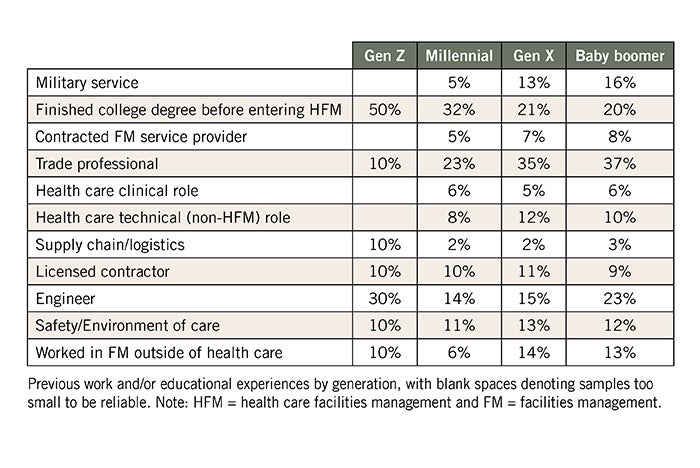The evolving facilities workforce pipeline
As the baby boomer generation increasingly exits the workforce, organizations nationwide struggle to identify workforce pipelines, entice qualified candidates to apply for open roles and strategically provide the education needed for workers to grow in their careers. This challenge particularly impacts health care facilities engineering, where more than a third of professionals are forecast to retire within the next five years.

Previous work and/or educational experiences by generation, with blank spaces denoting samples too small to be reliable. Note: HFM = health care facilities management and FM = facilities management.
Data from 2023 ASHE Membership Survey
To provide insight into workforce development strategy, the American Society for Health Care Engineering’s most recent membership survey explored respondents’ pipeline and previous work histories through a generational lens. It found only 1% of the survey’s 1,336 respondents were members of Generation Z (12 to 27 years old), 9% were millennials (28 to 43 years old), 52% were Generation X (44 to 59 years old) and the remaining 39% were baby boomers (60 to 78 years old). These numbers are representative of the overall health care facilities management profession.
As expected, almost a quarter of all respondents (22%) had previously worked in the trades; 18% had either worked in environment of care or safety (9%) or in facilities management outside of health care (9%); and an additional 10% had served in the military.
All generations were equally likely to have entered the health care facilities management pipeline through previous clinical or technical roles, safety or environment of care, or to have been employed as licensed contractors. However, younger generations were significantly less likely to report military service and to have worked within the trades.
Additionally, younger generations were more likely to report obtaining their college degree before entering health care facilities management and were more likely to have heard about the profession during college. Twenty percent of Gen Zers heard about the field in college, compared to just 5% of millennials, 2% of Gen Xers and 1% of baby boomers.
Furthermore, an interesting U-shaped curve was found where Gen Zers (30%) and baby boomers (23%) were significantly more likely to report having their engineering designation as compared to millennials (14%) and Gen Xers (15%). This finding can be related to the fact that the engineering designation has required a college degree for the past few decades, but it had not been required prior to that.
These results mimic a nationwide preference for college education as well as a lack of interest in trades roles over the past few decades. However, recent reports have suggested a potential resurgence in trades roles due to high demand and lucrative career potential. Thus, these two trends present a unique, yet surmountable, challenge for health care facilities workforce development. The profession should consider using a dual-pronged approach to customize outreach and training, capitalizing on two different potential pipelines.
First, organizations should consider partnerships and apprenticeships that recruit within the junior high and high school systems, emphasizing the benefits of a lucrative, debt-free, noncollege-degreed career path. Second, organizations should embrace the upcoming large cohort of college-educated individuals, even though retiring health care facilities management professionals may have had a different educational experience.
Health care facilities departments should be open to exploring the concrete value of college-educated workforce entry while finding ways to definitively assess for potential knowledge gaps relevant to the role and finding the appropriate education that will fill these gaps. Although these two strategies are very different, it is likely that both will be needed to fill the giant shoes of our exiting baby boom generation.
About this column
“Data Driven Insights” provides a primer on research basics and shares recent innovations and concrete answers by showcasing the collaborative applied research efforts of the American Society for Health Care Engineering members, academics and scientists and other related professionals working within complementary fields.
Lisa Walt, Ph.D., senior researcher and methodologist, American Society for Health Care Engineering.




